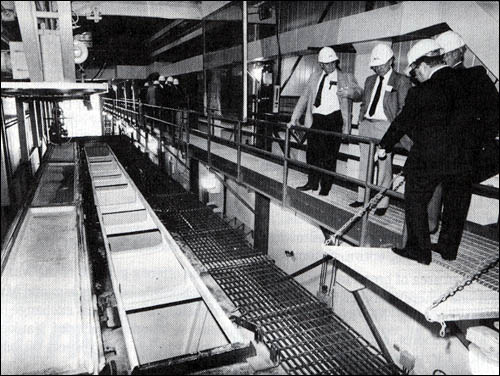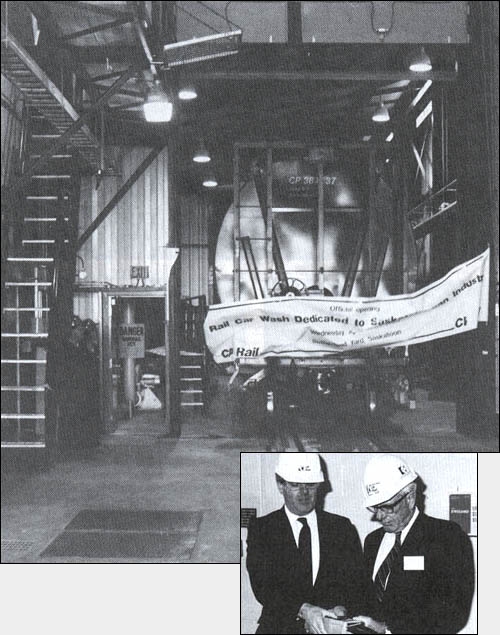Vol. 18 No. 6
June, 1988
|
Make Tomorrow Happen
|
Potash Cars Get Squeaky Clean
By Paul Thurston

Close Look: Railway officers and invited guests take a
closer look at CP Rail's new
rail car cleaning facility in Saskatoon.
 Saskatoon - A $3.7-million rail car cleaning
plant was officially opened here recently in a ceremony described as a sign of "our wholehearted commitment to
the saskatchewan potash industry".
Saskatoon - A $3.7-million rail car cleaning
plant was officially opened here recently in a ceremony described as a sign of "our wholehearted commitment to
the saskatchewan potash industry".
The new car wash building and 2.73 kilometres of redesigned track layout have been constructed at the freight
sorting yard in suburban Sutherland to expand the capacity of the railway's main operations base for potash
transportation in Saskatchewan.
"CP Rail has worked with the potash industry for more than 10 years to put greater speed, efficiency, and
quality into the all important transportation component of the business", said J.D. Bromley, executive
vice-president, Heavy Haul Systems.
"The construction of this facility in Saskatoon is a sign that we intend to be part of a very bright future
for the industry", Mr. Bromley told a group of government and industry officials gathered for the event.

J.D. Bromley, executive vice-president, Heavy Haul
Systems®, and Ray Meiklejohn,
minister of science and technology and minister of consumer and commercial
affairs,
press the button to bring the first rail car into the new plant for
cleaning.
INTERIORS DONE
Unlike the car wash at the corner gas station, the Saskatoon plant has been specially designed to clean interiors.
Equipped with high-pressure water jets amounted on an overhead crane, the shop is used to ensure that
Saskatchewan potash shippers have a reliable source of clean equipment that will not cause contamination of a
product that has earned and enviable reputation for purity.
The shop is part of a complex which has inbound and outbound holding yard capacities totaling about 100 cars, more
than enough to keep a two person shift busy for eight hours.
"Phased construction and re-use of track material helped us reduce cost and disruption to the
previously existing dry cleaning plant, which has been kept operational since work on this project began last
May", said John Fox, vice-president of CP Rail's Calgary-based special projects
group which supervised engineering and construction.
HEAVY DEMAND
The 71.5-metre-long wash building is made up of three separate sections for heating, washing, and
drying the interiors of covered hopper cars that are in heavy demand for both potash and grain service.
"We'll be able to move cars from one type of service into another much more quickly with the new shop",
said Mark Mudie, superintendent, Saskatoon Division.
Doors measuring 6.1 metres in height are located at the entrance to the wash section and exit of the drying section
of the single-track shop, which is capable of holding three cars at a time.
An operator's walkway runs along the length of the wash and drying sections at car-top level.
At its highest point, the car cleaning plant is 1.7 metres tall. A small adjoining building houses a
waste-water treatment system along with other mechanical and electrical equipment and services.
During cold weather operation, cars entering the first section of the wash building are stationed between rows of
gas-firedheaters capable of warming a 27-tonne piece of equipment to just above the
freezing point in 20 minutes.
After frozen deposits have been thawed, the car is moved ahead to the washing section where an operator individually
cleans each hopper compartment (there are normally four compartments a car) with a remote-controlled
washing wand.
The wand is lowered into each compartment and cleans with a high-pressure, rotating spray.
Wash water flows to the high-pressure jets only when the wand is fully lowered, and the overhead crane
cannot move unless the wand is fully raised.
After washing, each hopper car is moved to the third and final section of the building for drying.
Rooftop heaters maintain a minimum working temperature of 18 degrees Celsius and supply drying air through flexible
ducts placed in each hopper car compartment.
To avoid the use of locomotives or other self-propelled motive power units in the immediate area of the
shop, CP Rail engineers have incorporated in-track car pullers in the design.
Drive assemblies and take-up gears have been located in a concrete base which extends all the way
through the building and for several metres beyond each end.
Movement of cars - singly or in groups of three - is done with pop-up robots which nudge axles forward
at a crawl, and are retracted below the rails when not in use.
The robots are controlled from a panel located at the entrance to the building, and cannot move unless the washing
wand is raised. Various other safety features include interlock systems to prevent movement while doors are closed,
and flip-up motion arrestors on the rails.
CITY STANDARDS
Liquid from the cars in any of the pre-heat, wash, or drying section is discharged to city sewers after
treatment to bring contamination levels into line with standards set by a City of Saskatoon industrial waste bylaw.
Waste water drains into an open trench sloped to a pit near the centre of the wash building. From this pit a pump
moves the waste to treatment equipment in the adjoining service building.
Located 280 metres to the east of the wash building is the two-track, 14-car dry cleaning
pit. The inner rails of each track rest on concrete pedestals about one metre above a paved and drained apron.
The dry cleaning operation begins after eight cars on one track have been positioned over the pit. Hopper car
unloading gates are opened and waste material falls between the tracks to the pavement below for subsequent
disposal.
The gates and lower areas of car compartments are cleaned by an operator using a compressed air wand. An inspector
walks along the open hatch covers atop the cars to visually check interior cleanliness.
Cars needing further cleaning join others already on their way to the new car wash.
This Canadian Pacific
Railway News article is copyright 1988 by the Canadian Pacific Railway and is reprinted here
with their permission. All photographs, logos, and trademarks are the property of the Canadian Pacific Railway
Company.
|
|